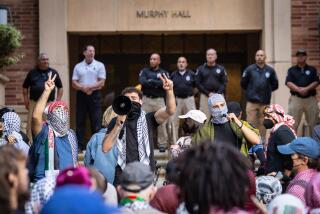When Guard Bosses Let California Down : Fair, convincing report details what went wrong in riots
The evident and serious shortcomings in the California National Guard’s initial response to last spring’s riots in Los Angeles have now been documented in a comprehensive report to Gov. Pete Wilson. The study, by retired Army Gen. William H. Harrison, details “absolute failures” on the part of the Guard in its training and readiness to cope with civil disturbances, and in its deployment once Wilson ordered it into action after it became clear that local authorities could not cope with the looting and arson.
The report finds no fault with the dedication and courage of members of the Guard who were called to duty--and who, it says, acquitted themselves creditably. Harrison puts blame instead on higher authority: on the Guard’s commanders; on the federal government, which, dime-wise and dollar-foolish, had earlier withdrawn its funding for planning to deal with civil disorders; on the Administration of Gov. George Deukmejian, which allowed a rapid-response unit created during Gov. Edmund G. (Jerry) Brown Jr.’s tenure to wither through lack of support.
A big part of the problem, Harrison writes, was that the Guard lacked “a civil disturbance mentality,” something clearly reflected in the kind of training and equipment it had been given. One cause of this was tight budgets. Another was a belief--or at least a hopeful expectation--that local law enforcement agencies could by themselves control rioting if it broke out. But, at the same time, the Guard was required by state and federal regulations to maintain a force of 5,000 specially trained and ready to deal with civil disturbances. “For all intents and purposes,” writes Harrison, (this force) “did not exist.”
It was quickly revealed during the rioting that the absence of preparation had its counterpart in a lack of necessary equipment. Earlier, the Guard had riot gear: shields, face protectors, gas masks and the like. But because senior officers believed that the Guard’s intervention probably wouldn’t be required, much of this equipment was lent to local police departments. When the Guard was mobilized, it had to borrow riot equipment from other states. Even in the most basic areas, poor planning slowed the Guard’s response time. Rifle ammunition, to take the most glaring example, wasn’t available until hours after the Guard reached Los Angeles, delaying the time when it could have hit the streets and begun to help restore order.
Inadequate forethought led to bungling at every turn. It’s clear from Harrison’s after-action report what the Guard must do to prepare for future domestic missions. First, it needs enough money--probably not a lot--to train properly for dealing with urban violence and to have the right equipment, including communications, for a prompt and competent response. Funding for that should come from the Pentagon. Second, the Guard needs to develop and inculcate the kind of “civil disturbance mentality” whose absence, as Harrison noted, reduced its effectiveness. It is grossly unfair to the volunteer men and women of the Guard to deny them the training and material they need to be competent in controlling civil disorders. It is no less unfair to the people of California, for it is their lives and property that are ultimately at stake.
More to Read
Sign up for Essential California
The most important California stories and recommendations in your inbox every morning.
You may occasionally receive promotional content from the Los Angeles Times.










